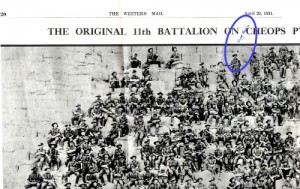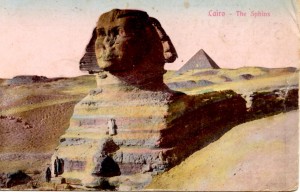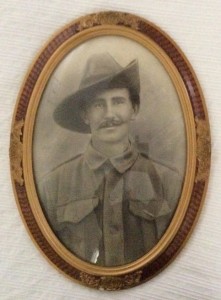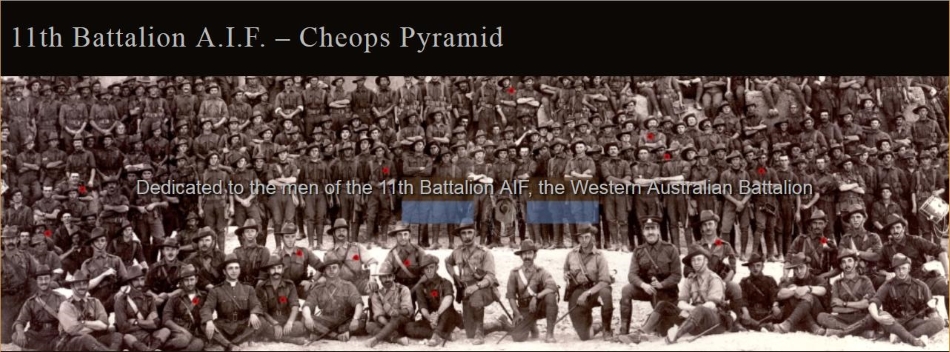 Hugh Richard (Dick) BIGGIN - KIA - ID# 009
Hugh Richard (Dick) BIGGIN - KIA - ID# 009
"Yours till the cows come home"
True to character, the charismatic larrikin, Hugh (Dick) Biggin undertook the strenuous climb to the top of the Cheops Pyramid on that tenth day of January 1915. There he was photographed amidst his 11th Battalion comrades, bayonet in hand and a half smile on his handsome face. He was but metres away from a relative by marriage, David (Pink Top) Simcock who occupied the uppermost position on the pyramid.
A Lovable Larrikin
In 1931 when The Western Mail published a copy of the 11th Battalion Cheops photo in their Anzac Day issue, Dick’s family marked his position in the photo and kept the page as a reminder of their much loved brother. However, it’s somewhat surprising that Dick was actually photographed that day on the pyramid, for in a letter to his younger brother Harry, written the following week he revealed
Today is Sunday and I had such a lot of trouble to dodge church parade, however I managed it by falling in and answering my name and then falling out again while no one was looking. Pretty hard luck when one has just got to go to services isn’t it?
 The Western Mail, April 23 1931, Hugh BIGGIN marked
The Western Mail, April 23 1931, Hugh BIGGIN marked
Clearly he hadn't fallen out the previous Sunday! Church attendance was obviously not a priority for Dick.
A family member disclosed;
His father Henry, fattened steers to sell and couldn’t understand why he had difficulty keeping condition on them. Hugh (Dick), apparently, would stay home from church, riding the beasts to keep himself amused.
A familiar family dilemma
Dick also revealed in his letter the dilemma facing many Australian families with several sons all keen to enlist and ‘do their bit’
I’m surprised at you, you ought to know better. But joking aside, you know very well that it is up to you to stop home, someone must stop to run the farm and under the circumstances it is your place to stay behind, it’s different with me. I consider myself free all round and so it is just as much my duty to be where I am, as it is your duty to be at home, even if another contingent go, do you think that you should really? It’s different when men are getting short, but should they thin out all Australia more than any other portion of the Empire?
Dick closed his letter with
'Yours till the cows come home'
Harry did indeed join up the following year and left Australia as one of the 17th Reinforcements of the 11th Battalion only four months before his beloved brother Dick was killed in action at the Mouquet Farm, France.
The story of Hugh (Dick) Biggin and a loving tribute from his great niece, Lorraine Ardagh follows:
An idyllic childhood
Dick was born on the Cam River, Somerset, Tasmania on 27th October 1890 to Maggie and Henry Biggin. He was the 8th child in a family of 11, his surviving siblings being Bill, Jack, Annie, Sophie, Susan, Chris, Peggy, Molly and Harry. When he was born his parents owned the Emu Bay Butter factory Company but prior to that had spent their lives farming in the Neuarpurr region of South Australia.
Dick’s first 13 years were from all accounts, an idyllic childhood. He helped out at the factory, attended the Somerset school, loved to fish and play by the river with his many siblings, and like most of his family loved sport, especially cricket and tennis. Hoping to improve themselves, and with the knowledge that good farming country was being opened up in Western Australia, in 1903 Henry and Maggie returned to farming and moved to Marwonga near Pingelly in WA.
Dick possibly had only one year at the local school. He was a good student and liked to read the popular literature of the day. He appreciated poetry, writing out fully his favourite prose. From 1913 to 1915 he attempted to keep a diary, writing down his thoughts and infrequently his activities. He was musical, enjoying organ practice and a good book but says life is pretty boring, just farm work, clearing land and assisting his father and brothers. His writing indicates him to be restless. The West Australian of 21st February 1910 reported
Mr Hugh Biggin, while riding home with several comrades on Sunday week was the victim of a particular accident. A calf, lying on the roadside, ran and collided with his horse, completely upsetting it, and young Biggin was thrown off. His shoulder was knocked out of joint and was afterwards reset by Br Corbey
Memories of Hugh’s life, from his siblings, tell a different story. He was handsome, well liked and a bit of a larrikin. He was a very good horseman, and rose to the challenge when someone dared him to ride his horse across the rails of the Marwonga Bridge. His father Henry fattened steers to sell and couldn’t understand why he had difficulty keeping condition on them. Hugh, apparently, would stay home from church, riding the beasts to keep himself amused. Everyone loved Hugh, especially young Harry, as he appeared so popular and carefree. As did many other young farmers wanting to earn good money to establish themselves, Dick left home to go shearing.
Duty Calls
He was in Carnarvon, about 900km North of Perth, when WWI broke out and imagined an adventure, so Dick enlisted and travelled back to Perth, arriving at Blackboy Hill on 25th August 1914. His service number was 150.
P ostcard from Egypt - Aug 1916
ostcard from Egypt - Aug 1916
Belonging to the original 11th Battalion, he travelled via the troop ship, “Ascanius” to Alexandria. A famous photograph was taken of the Battalion standing on the Cheops Pyramid in Egyptian just before they left for the shores of Gallipoli. Dick however, developed pleurisy, tonsillitis, a dilated heart and pancreatitis from exposure whilst aboard ship and was declared unfit for six months and returned to Australia in August 1915 aboard the, “Kyarra”, entering Fremantle Hospital on his return.
On 31st December 1915 he was declared fit and posted to France, joining B Company, travelling back to France aboard the, “Caledonia”.
Sadly, on 20th–23rd August 1916 near Mouquet Farm, France, Dick was killed by shell fire whilst manning a Lewis Gun.
Friends whom had known him from shearing days on the Murchison saw him fall and testified to the event. The family felt Dick’s death keenly and a large picture of him hung over the fireplace in the family home at Pingelly. The picture remained in that place until 1974, when it was inherited by nephew, Richard (Dick) Biggin. The portrait photo now hangs in the home of Dick’s daughter Susan Biggin.
Both his brother Harry and sister Sophie named their sons Richard in his honour. Until they passed away, all his siblings liked to recall the adventures and antics of their beloved brother Dick.
Hugh Richard BIGGIN
11th Battalion AIF Pte 150
Studio portrait
Tribute researched and written by Lorraine Ardagh, great niece of Hugh (Dick) Biggin
Introduction by Julie Martin



